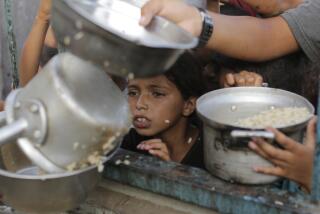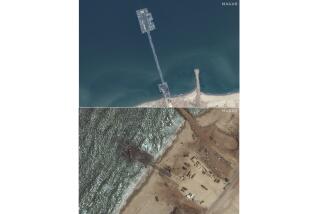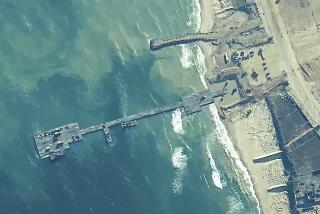Aid Convoy Ends Somalia Standoff : Relief: Trucks laden with food are the first to make it out of the capital’s port in a month. Militias that had barred the way capitulate as Marines mass offshore.
MOGADISHU, Somalia — A relief convoy ended a month-old standoff with warring militias Sunday and left the capital’s chaotic port to deliver food to an isolated part of the city as U.S. Marines massed offshore.
The convoy of 40 trucks was the first such convoy to make it safely out of the port in more than a month--since before the port was shelled Nov. 7 and a 34-truck shipment was ambushed four days later on its way to the famine zone in the interior, with as many as 40 of its guards killed.
It may also have marked a new spirit of cooperation between the clan militias whose mutual antagonism has split this city in two and made the delivery of food aid a near impossibility throughout Somalia.
The reason may very well be the advance party of U.S. Marines now offshore and preparing to land here early this week to impose some badly needed order in Mogadishu.
The convoy had originally been scheduled to leave Saturday but was canceled when militias guarding the Green Line dividing the city demanded 20 tons of food for handling it. The gunmen capitulated later as the hour neared for the landing of the first wave of U.S. troops.
The first thousand or so U.S. troops, out of a force that may ultimately exceed 28,000 troops from the United States and a dozen other countries, were preparing an amphibious assault on Mogadishu and other points in the country from a naval task force now standing about 50 miles off the coast.
The operation could begin as early as before dawn Tuesday, according to speculation here. At that point, Marines are likely to strike first at Mogadishu’s old International Airport, securing the runway for the arrival of airborne units.
The multinational force’s objective is to secure ports, delivery routes and distribution points for the roughly 40,000 tons of relief food needed monthly in Somalia to stave off starvation for as many as 2.5 million people. The ultimate aim is to break the cycle of extortion and menace that has prevented convoys like Sunday’s from reaching their destinations intact.
The famine zone covers much of the southern third of this country on the Horn of Africa--south of a line running roughly northwest from the coastline above Mogadishu--a region where damage from three successive annual droughts was compounded by implacable factional fighting over the last 18 months.
Although drought also has affected the north of Somalia, that area has not suffered from the same degree of civil war or general anarchy, and relief food has been arriving there regularly, averting famine.
Outside Mogadishu, the impending arrival of foreign troops continues to generate increasing menace for relief workers in the center of the famine zone. For the second time in two days, gunmen Sunday attacked CARE International’s compound in Baidoa, a town 160 miles northwest of the capital. Baidoa is one of the worst-hit famine centers, and its relatively well-maintained tarmac airstrip may be a key objective for the multinational force.
The second day of violence directed at CARE prompted the agency to evacuate all but two of its 20-person foreign staff from the town.
“Security just fell apart,” said Rick Grant, a CARE spokesman in Mogadishu. “The local governor locked himself in his house, the chief of police has fled to Mogadishu, and our people thought they would be killed.”
The British news agency Reuters later reported that clan fighting had killed 24 people in Baidoa on Sunday.
Aid sources told Reuters that the Dutch wing of Medecins Sans Frontieres (Doctors Without Borders), a French-based international medical relief organization, had cut its staff in Baidoa from 13 to three. The Irish agency World Concern, which had 17 women in the town, was also cutting down to five people.
“People in Baidoa are aware that the U.S. is coming, and they’re already reacting,” said Linda McClelland, a spokeswoman for the group.
Still, relief officials in Mogadishu took the success of Sunday’s food convoy as a good sign, and an unexpected one.
“If the convoy goes, I’ll be delighted,” Rhodri Wynn-Pope, CARE’s local chief, had said before the mission began. “If it doesn’t, it’s just another one down.”
The old system of extortion, which cost CARE as much as $3,000 a day to pay off 900 armed “security guards” at the port--as well as a tribute of 60 tons of food from each ship that docked--had not kept the port from being one of the most insecure swatches of territory in Mogadishu. Thousands of tons of food have remained in a port warehouse for weeks because of the likelihood that it would be looted as soon as it was loaded for transport out of the port area.
But Sunday before 9 a.m., the line of World War II-vintage Italian trucks, each laden with 10 tons of U.S. and European wheat packed in plump sacks, filled the port area with clouds of acrid black smoke as their engines churned to life.
Flanked by heavily armed jeeps, the convoy moved through the port gates without incident. The scene was so tranquil that CARE and the U.N. World Food Program loaded up another 61 trucks and sent them across the Green Line later in the day, for a total delivery of 1,010 tons of food for the north of the city--its first significant ration in weeks.
RELATED STORY: A3
More to Read
Sign up for Essential California
The most important California stories and recommendations in your inbox every morning.
You may occasionally receive promotional content from the Los Angeles Times.










